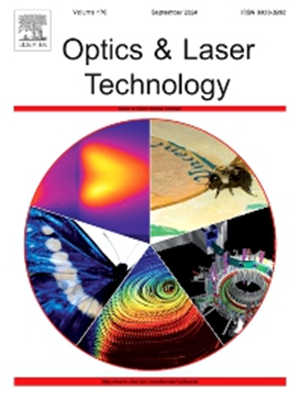Parallel waveguide fiber Bragg gratings – Used for detecting human respiratory rate, trunk status, and pulse
IF 4.6
2区 物理与天体物理
Q1 OPTICS
引用次数: 0
Abstract
The indicators of respiratory rate (RespRate), heart rate (HR), and arterial pulse waveform (APW) directly reflect human health levels. Therefore, it is crucial to monitor these indicators. This article introduces a parallel waveguide fiber Bragg grating (PWFBG) sensor capable of measuring respiratory rate and either trunk bending or pulse, and estimating HR based on the measured pulse. Traditional measurement methods require separate sensors for each parameter, leading to increased complexity and cost. We used femtosecond (fs) laser to inscribe a coupling waveguide in a single-mode fiber (SMF), and then inscribed two Fiber Bragg Gratings (FBGs) with different center wavelengths in the fiber core and waveguide respectively, to create the PWFBG structure. To reduce demodulation costs, we made the two FBGs corresponding to the sensor into filters. By using the edge filtering method, we achieved intensity demodulation of the sensor. Finally, the PWFBG structure is encapsulated in polydimethylsiloxane (PDMS) and fixed on the human chest or neck to measure respiratory rate and the degree of trunk bending or pulse. Experimental measurements show that the proposed sensor structure is highly sensitive to human respiration and pulse, and can also assess the degree of trunk bending. In tests, volunteers’ heart rates were 84 bpm at rest, 12 bpm after exercise, and 104 bpm after resting, with results comparing favorably with commercial instruments, falling within the ± 1.96 SD range, demonstrating the sensor’s accuracy. Additionally, the core FBG and waveguide FBG have similar temperature responses (17 pm/℃ and 18.1 pm/℃ respectively), allowing the core FBG to compensate for the temperature changes affecting the waveguide FBG. This sensor has significant potential for health monitoring, health management, and biological research, especially in high magnetic field environments like magnetic resonance imaging (MRI).
平行波导光纤布拉格光栅 - 用于检测人体呼吸频率、躯干状态和脉搏
呼吸频率(RespRate)、心率(HR)和动脉脉搏波形(APW)等指标直接反映人体健康水平。因此,监测这些指标至关重要。本文介绍了一种平行波导光纤布拉格光栅(PWFBG)传感器,它能够测量呼吸频率和躯干弯曲或脉搏,并根据测量到的脉搏估算心率。传统的测量方法需要为每个参数配备单独的传感器,从而增加了复杂性和成本。我们使用飞秒(fs)激光在单模光纤(SMF)中刻入耦合波导,然后在光纤纤芯和波导中分别刻入两个中心波长不同的光纤布拉格光栅(FBG),从而形成 PWFBG 结构。为了降低解调成本,我们将与传感器相对应的两个 FBG 制作成滤波器。通过使用边缘滤波方法,我们实现了传感器的强度解调。最后,将 PWFBG 结构封装在聚二甲基硅氧烷(PDMS)中,并固定在人体胸部或颈部,以测量呼吸频率、躯干弯曲程度或脉搏。实验测量结果表明,所提出的传感器结构对人体呼吸和脉搏高度敏感,还能评估躯干弯曲程度。在测试中,志愿者的心率在静息时为 84 bpm,运动后为 12 bpm,静息后为 104 bpm,结果与商用仪器相比毫不逊色,均在± 1.96 SD 范围内,证明了传感器的准确性。此外,核心 FBG 和波导 FBG 具有相似的温度响应(分别为 17 pm/℃ 和 18.1 pm/℃),使核心 FBG 能够补偿影响波导 FBG 的温度变化。这种传感器在健康监测、健康管理和生物研究方面具有巨大潜力,尤其是在磁共振成像(MRI)等高磁场环境中。
本文章由计算机程序翻译,如有差异,请以英文原文为准。
求助全文
约1分钟内获得全文
求助全文
来源期刊
CiteScore
8.50
自引率
10.00%
发文量
1060
审稿时长
3.4 months
期刊介绍:
Optics & Laser Technology aims to provide a vehicle for the publication of a broad range of high quality research and review papers in those fields of scientific and engineering research appertaining to the development and application of the technology of optics and lasers. Papers describing original work in these areas are submitted to rigorous refereeing prior to acceptance for publication.
The scope of Optics & Laser Technology encompasses, but is not restricted to, the following areas:
•development in all types of lasers
•developments in optoelectronic devices and photonics
•developments in new photonics and optical concepts
•developments in conventional optics, optical instruments and components
•techniques of optical metrology, including interferometry and optical fibre sensors
•LIDAR and other non-contact optical measurement techniques, including optical methods in heat and fluid flow
•applications of lasers to materials processing, optical NDT display (including holography) and optical communication
•research and development in the field of laser safety including studies of hazards resulting from the applications of lasers (laser safety, hazards of laser fume)
•developments in optical computing and optical information processing
•developments in new optical materials
•developments in new optical characterization methods and techniques
•developments in quantum optics
•developments in light assisted micro and nanofabrication methods and techniques
•developments in nanophotonics and biophotonics
•developments in imaging processing and systems

 求助内容:
求助内容: 应助结果提醒方式:
应助结果提醒方式:


